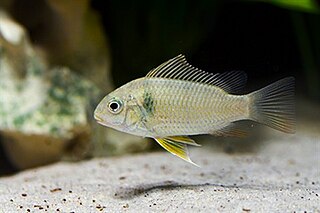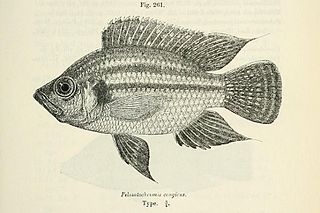
Tilapia is the common name for nearly a hundred species of cichlid fish from the coelotilapine, coptodonine, heterotilapine, oreochromine, pelmatolapiine, and tilapiine tribes, with the economically most important species placed in the Coptodonini and Oreochromini. Tilapia are mainly freshwater fish inhabiting shallow streams, ponds, rivers, and lakes, and less commonly found living in brackish water. Historically, they have been of major importance in artisanal fishing in Africa, and they are of increasing importance in aquaculture and aquaponics. Tilapia can become a problematic invasive species in new warm-water habitats such as Australia, whether deliberately or accidentally introduced, but generally not in temperate climates due to their inability to survive in cold water.

Oreochromis is a large genus of oreochromine cichlids, fishes endemic to Africa and the Middle East. A few species from this genus have been introduced far outside their native range and are important in aquaculture. Many others have very small ranges; some are seriously threatened, and O. ismailiaensis and O. lidole possibly are extinct. Although Oreochromis primarily are freshwater fish of rivers, lakes and similar habitats, several species can also thrive in brackish waters and some even survive in hypersaline conditions with a salinity that far surpasses that of seawater. In addition to overfishing and habitat loss, some of the more localized species are threatened by the introduction of other, more widespread Oreochromis species into their ranges. This is because they—in addition to competing for the local resources—often are able to hybridize.

Sarotherodon is a genus of oreochromine cichlids that are native to the northern half of Africa, with a single species, S. galilaeus, also ranging into the Levant. A couple of species from this genus have been introduced far outside their native range, and are important in aquaculture. Most other species have small ranges and some are seriously threatened. They mainly inhabit fresh and brackish water, but a few can live in salt water. Species in this genus, as well as those in several other oreochromine and tilapiine genera, share the common name "tilapia" and historically they were included in the genus Tilapia.

Steatocranus is a genus of small rheophilic cichlids mostly native to the Congo River Basin in DR Congo/Congo Brazzaville, although one species, S. irvinei, is restricted to the Volta River in Ghana and Burkino Faso, and it belongs in a separate genus. There are also at least c. 10 undescribed species in the Congo River basin awaiting scientific description.

Tilapia is a genus of cichlid fishes endemic to freshwater habitats in Southern Africa. In the past this was a very large genus including all species with the common name tilapia, but today the vast majority are placed in other genera.

Etia nguti is a species of cichlid fish endemic to Cameroon in Central Africa where it is only known from the Nguti River, a tributary of the Cross-Manyu River. This species can reach up to 13.3 centimetres (5.2 in) in standard length. It is the only member of its genus and tribe.

The spotted tilapia, also known as the spotted mangrove cichlid or black mangrove cichlid, is a species of fish of the cichlid family. It is native to fresh and brackish water in West and Central Africa, but has been introduced to other regions where it is considered invasive.

The Tilapiini are a tribe within the family Cichlidae commonly known as tilapiine cichlids. Formerly this tribe contained many other genera and species, including the economically important Oreochromis and Sarotherodon, but a taxonomic review found that this grouping was paraphyletic and most were moved to Coelotilapini, Coptodonini, Heterotilapini, Oreochromini and Pelmatolapiini. Together, most species in these tribes are called "tilapias". In a more distant past, a number of other, more different genera like Steatocranus also were included in Tilapiini. With these as separate, Tilapiini now is a much more restricted tribe with only three genera and about half a dozen species from Central and Southern Africa.

Stenostiridae, or the fairy flycatchers, are a family of small passerine birds proposed as a result of recent discoveries in molecular systematics. They are also referred to as stenostirid warblers.

The giant cichlid, also known as the emperor cichlid, is a species of fish in the family Cichlidae, endemic to Lake Tanganyika in Africa. It is the only member of its genus Boulengerochromis and tribe Boulengerochromini.

The redbreast tilapia is a species of fish in the family Cichlidae. It is found widely in the southern half of Africa. Its natural habitats are freshwater lakes and freshwater marshes. It is known as the redbreast kurper in South Africa.
Coelotilapia joka is a vulnerable species of cichlid fish from rivers in Sierra Leone and Liberia in West Africa. This relatively small tilapia formerly was included in the genus Tilapia, but in 2013 it was moved to its own genus Coelotilapia and tribe Coelotilapini.

The Pseudocrenilabrinae are a subfamily in the cichlid family of fishes to which, according to a study from 2004, includes all the Middle Eastern and African cichlids with the exception of the unusual Heterochromis multidens and the Malagasy species. This subfamily includes more than 1,100 species. Previous authors recognized additional African subfamilies, e.g. the Tilapiinae of Hoedeman (1947), Tylochrominae of Poll (1986), or Boulengerochrominae of Tawil (2001).

Tilapia busumana is a species of cichlid native to Lake Bosumtwi, the Bia River Basin, the Pra River Basin and the Tano River Basin in Ghana and Côte d'Ivoire. This species can reach a length of 18 centimetres (7.1 in) SL. It can also be found in the aquarium trade. In 2013, research published by Dunz & Schliewen indicated that this species does not belong in the genus Tilapia, but is rather closer to "Steatocranus" irvinei and Gobiocichla. It is currently retained in Tilapia pending further research.

Pterochromis congicus is a species of cichlid native to the Congo River Basin in Central Africa. This species can reach a standard length of 15.2 cm (6.0 in). This genus and Pelmatolapia are the only in the tribe Pelmatolapiini, but formerly they were included in Tilapiini.

Coptodon is a genus of cichlids native to fresh, brackish and coastal marine waters in Africa with C. zillii also found in the Middle East. It is the only genus in the tribe Coptodonini. Formerly included in Tilapia, this genus and tribe was separated in 2013. Despite the change in genus, Coptodon spp. are still referred to by the common name tilapia. Several species are important in local fisheries and a few are aquacultured.

Heterotilapia is a genus of cichlid fish that are native to rivers from Guinea-Bissau to Liberia in tropical West Africa. Formerly considered a subgenus of Tilapia, in 2013, it was elevated to genus rank. They are medium-large cichlids, up to about 20–30 cm (8–12 in) in standard length depending on the species, and with a distinctive dark-and-light banded pattern. They are substrate spawners and brooders. H. buttikoferi is a common species that also has been introduced outside its native range, but H. cessiana is highly localized and critically endangered.

The redbelly tilapia, also known as the Zille's redbreast tilapia or St. Peter's fish, is a species of fish in the cichlid family. This fish is found widely in fresh and brackish waters in the northern half of Africa and the Middle East. Elsewhere in Africa, Asia, Australia and North America, it has been introduced as a food fish or as a control of aquatic vegetation. Where introduced, it sometimes becomes invasive, threatening the local ecology and species. The redbelly tilapia is an important food fish and sometimes aquacultured.

Oreochromini is a tribe of cichlids in the Pseudocrenilabrinae subfamily that is native to Africa and Western Asia, but a few species have been widely introduced to other parts of the world. It was formerly considered to be part of the tribe Tilapini but more recent workers have found that the Tilapini sensu lato is paraphyletic. Despite this change, species in Oreochromini are still referred to by the common name tilapia and some of the most important tilapia in aquaculture —certain species of Oreochromis and Sarotherodon— are part of this tribe. In contrast, several species have small ranges and are seriously threatened; a few are already extinct or possibly extinct.

The Colubroides are a clade in the suborder Serpentes (snakes). It contains over 85% of all the extant species of snakes. The largest family is Colubridae, but it also includes at least six other families, at least four of which were once classified as "Colubridae" before molecular phylogenetics helped us understand their relationships. It has been found to be monophyletic.

















